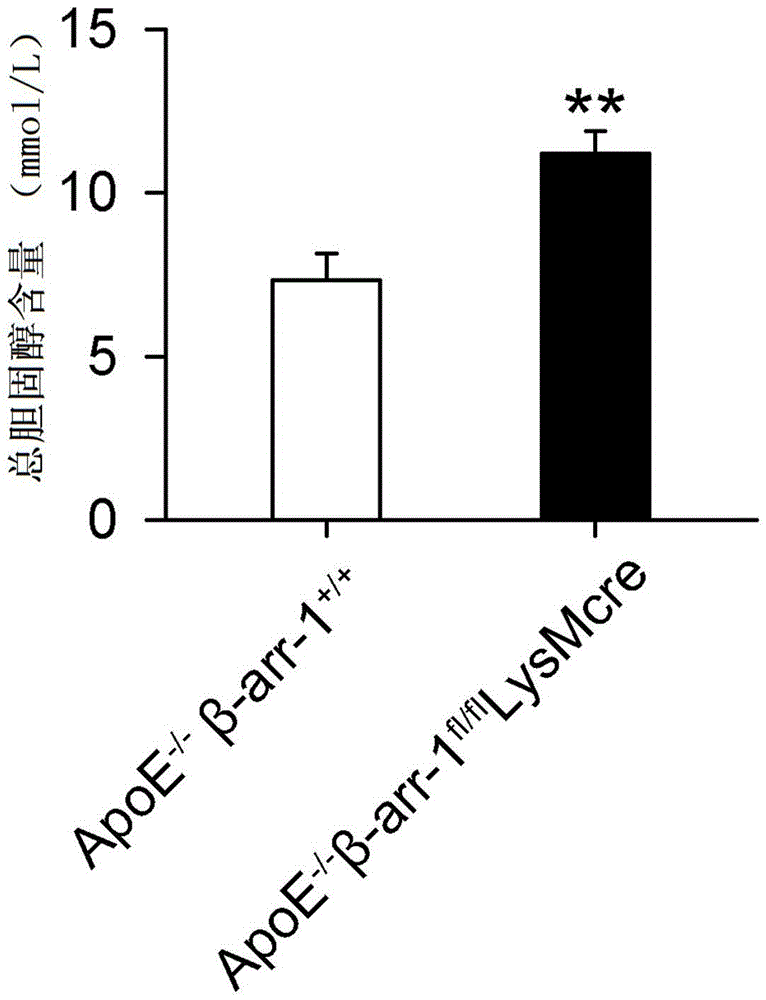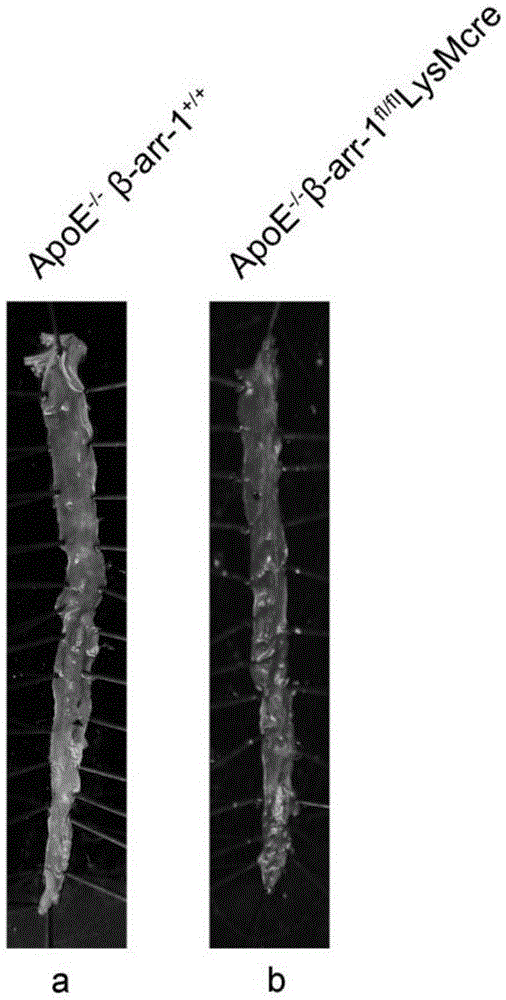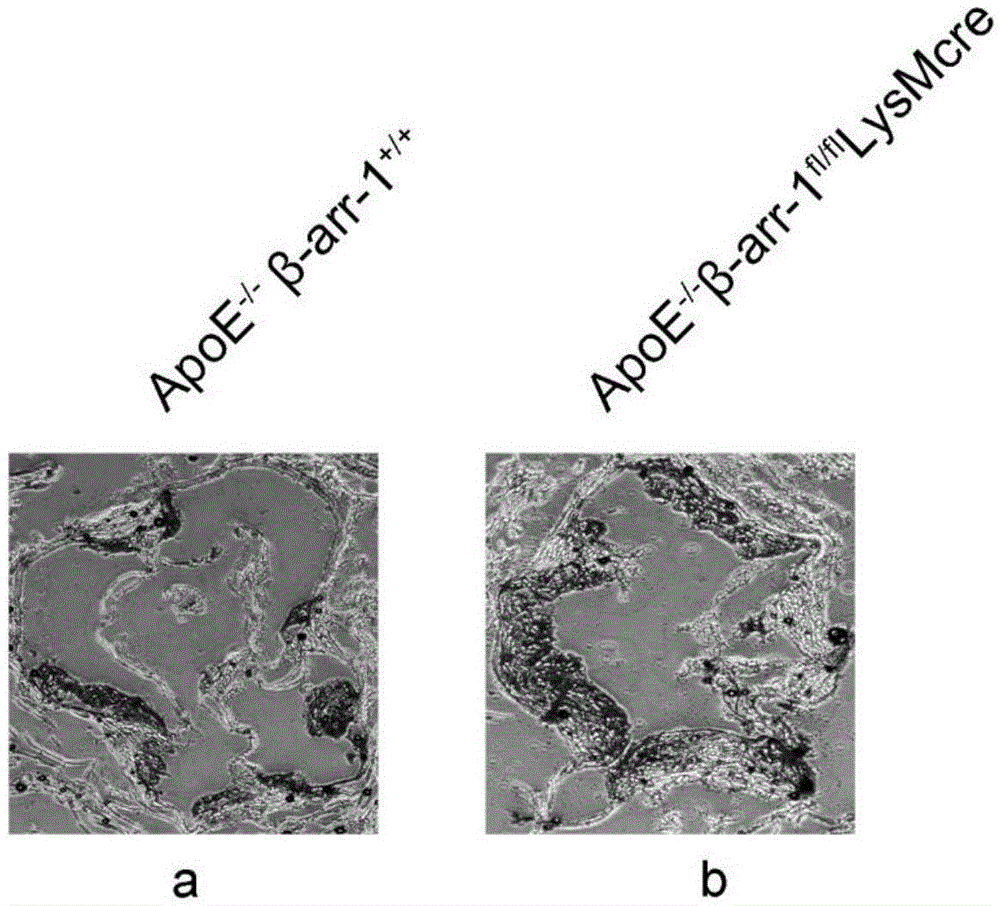Application of macrophage beta-profilin-1 to preparation of drug for preventing or treating atherosclerosis
A technology for atherosclerosis and macrophages, which is applied in the field of medicine, can solve the problems that there is no protective effect of macrophage β-arrestin, and achieve high safety effects
- Summary
- Abstract
- Description
- Claims
- Application Information
AI Technical Summary
Problems solved by technology
Method used
Image
Examples
Embodiment 1
[0027] Example 1: Effect of macrophage β-arrestin-1 gene on serum total cholesterol after atherosclerosis occurs.
[0028]The gene knockout method of macrophage β-arrestin-1-specific myeloid gene knockout mouse (β-arr-1fl / flLysMcre) is obtained through the Cre-Loxp recombinase system, that is, through the Cre mouse (purchased from the U.S. The Jackson Laboratory (The Jackson Laboratory, article number 004781, https: / / www.jax.org / strain / 004781) and Loxp mice (obtained from the Shanghai Institute of Biological Sciences, Chinese Academy of Sciences, cultivated by the institute itself), were provided by the inventor's laboratory Obtained by self-mating and breeding.
[0029] 1. Construction of a mouse model of atherosclerosis
[0030] The mice after bone marrow transplantation were raised in the marked SPF environment. Give high-fat feed (Western diet) (purchased from Shanghai Proton Biotechnology Co., Ltd.), and the formula is shown in the table below. After 12 weeks of feedin...
Embodiment 2
[0039] Example 2: Effect of macrophage β-arrestin-1 gene on the overall plaque area of aorta after atherosclerosis occurs.
[0040] Oil red O staining of the whole mouse aorta: the overall plaque area of the aorta was detected by oil red O staining of the whole aorta. The specific implementation method is as follows: take the mouse model of atherosclerosis caused by the above method, and inject 3.5% chloral hydrate into the abdominal cavity for anesthesia. The thorax of the anesthetized mouse was opened, and the heart and aorta were taken out after perfusion with normal saline and fixed in 4% paraformaldehyde for 24 hours. The whole aorta was dissected under the operating microscope, and the aorta was cut longitudinally with micro forceps and micro scissors to expose the aortic intima, and fixed with pins. Prepare oil red O dye solution (Zhuhai Beso). The aorta with flattened intima was placed in oil red staining solution for 15 minutes, followed by 70% ethanol color sep...
Embodiment 3
[0043] Example 3: Macrophage β-arrestin-1 gene affects aortic root plaque formation in atherosclerosis.
[0044] Oil red O staining of mouse aortic root: the overall plaque area of aorta was detected by oil red O staining of aortic root. The specific implementation method is as follows: take the mouse model of atherosclerosis caused by the above method, and inject 3.5% chloral hydrate into the abdominal cavity for anesthesia. The thorax of the anesthetized mouse was opened, and the heart and aorta were taken out after perfusion with normal saline and fixed in 4% paraformaldehyde for 24 hours. The mouse aortic root (at the aortic valve) was made into a frozen section with a thickness of 10 μm using a cryostat (purchased from Leica). Prepare oil red O staining solution. The frozen sections were washed in water for 30 seconds, wiped dry, and placed in oil red staining solution for 15 minutes, followed by 60% ethanol color separation for 1 minute and water washing for 1 minute...
PUM
 Login to View More
Login to View More Abstract
Description
Claims
Application Information
 Login to View More
Login to View More - R&D
- Intellectual Property
- Life Sciences
- Materials
- Tech Scout
- Unparalleled Data Quality
- Higher Quality Content
- 60% Fewer Hallucinations
Browse by: Latest US Patents, China's latest patents, Technical Efficacy Thesaurus, Application Domain, Technology Topic, Popular Technical Reports.
© 2025 PatSnap. All rights reserved.Legal|Privacy policy|Modern Slavery Act Transparency Statement|Sitemap|About US| Contact US: help@patsnap.com



